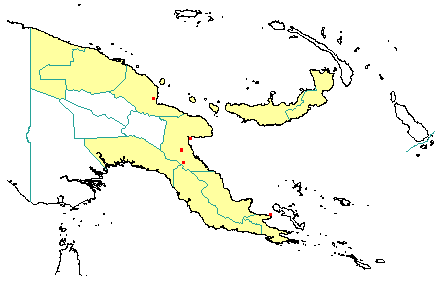
in PNGplants database
PNGTreesKey – Pterocymbium beccarii K.Schum. |
Barry Conn (NSW) & Kipiro Damas (LAE).
Guide to trees of Papua New Guinea
Copyright held by the authors, National Herbarium of New South Wales, and Papua New Guinea National Herbarium
Botanische Jahrbucher für Systematik, Pflanzengeschichte und Pflanzengeographie Vol. 24, Beiblatt 58: 21 (1897)
Family: Malvaceae
Dicotyledon
Timber Group: Major exportable hardwood
Field Characters: Large canopy tree (mostly 40-63 m high); Bole cylindrical (up to 50 cm diam., rarely to 85 cm); straight (bole up to 38 m long); buttresses buttresses present or occasionally buttresses absent; spines spines absent; aerial roots aerial roots absent; stilt roots stilt roots absent; Bark green (stripes), grey, or pale brown, slightly rough or smooth, slightly fissured, scaly or flaky (slightly (mostly smooth), or scattered pustular, lenticels elongated vertically; Subrhytidome (under-bark) grey (greenish (mottled), pink, white, or green; less than 25 mm thick or usually more than 25 mm thick, 20.0-35.0; bark blaze consisting of one layer; strongly aromatic; pleasant; outer blaze orange (pale (streaks), white (cream-coloured), or pink (pale (streaks), speckled or with stripes (pink and orange), fibrous or granular without splinters; inner blaze orange (pale (streaks), white (cream-coloured), or pink (pale (streaks), speckled or with stripes (pink and orange), fibrous or granular without splinters; bark exudate (sap) present or absent, colourless, not readily flowing (spotty), colour not changing on exposure to air, not sticky; terminal buds not enclosed by leaves.
Indumentum: Complex hairs present, star-like (stellate); stinging hairs absent; mature twig indumentum (hairs) present when young or soon absent, hairs somewhat dense.
Leaves: Leaves clustered at end of branches or slightly spaced along branches, spiral (leaves occurring singly at a node and arranged spirally up the branchlet), simple (a leaf composed of a single blade); petiole present, not winged, attached to base of leaf blade, not swollen; leaves broadest below middle, (65.0-) 70.0-100.0 cm, 60.0-90.0 cm; symmetric, entire, not dissected or lobed, obtuse or slightly acuminate, venation palmate, secondary veins open, prominent, intramarginal veins absent; leaves lower surface pale green or green, upper surface green (glossy), indumentum (hairs) absent (above) or present (below), indumentum (hairs) somewhat dense; absent; domatia absent; stipules absent.
Flowers: Inflorescence axillary (mostly after leaves have fallen off), flowers on a branched axis, cones absent; flowers unisexual, unisexual with male and female flowers on the same plant, stalked, flowers with many planes of symmetry, 10.0 (c.) mm long, diameter large (more than10 mm diam.) (6-8 mm diam.); perianth present, with all sepals and/or petals (hence tepals) similar, inner perianth white, blue, or red (inner surface); 5, some or partly joined (forming a perianth tube and 5 lobes); stamens 15, absent, joined (forming a staminal column), free of the perianth; ovary superior, carpels joined (when more than one), locules 1; styles absent or solitary (short), 1.
Fruits: Infrutescence arranged on branched axis (fruit surrounded by a membranous slipper-like wing), fruit 50.0-60.0 mm long, 6.0-8.0 mm diam., yellowish brown or yellowish green, not spiny, fleshy, simple, dehiscent, follicle; seeds 1-2, about 10 mm long (c. 8 mm long), not winged (Soon after fertilization, the follicle splits on one side and develops into a large membraneous boat-shaped wing; the exposed seeds develops at or near the base of the open carpel. At maturity the seeds are dispersed, attached to the follicle 'wall' which acts as wings.), broad (as wide as long), seed 1-10 mm diam.
Distribution: West Sepik, East Sepik, Madang, Morobe, Gulf, Central, Northern, Milne Bay & New Britain.
 | Botanical records in PNGplants database |
Notes: Notes The genus Pterocymbium was previously classified in the family Sterculiaceae.